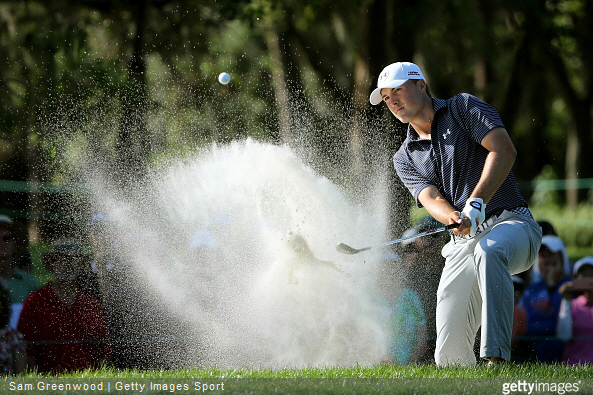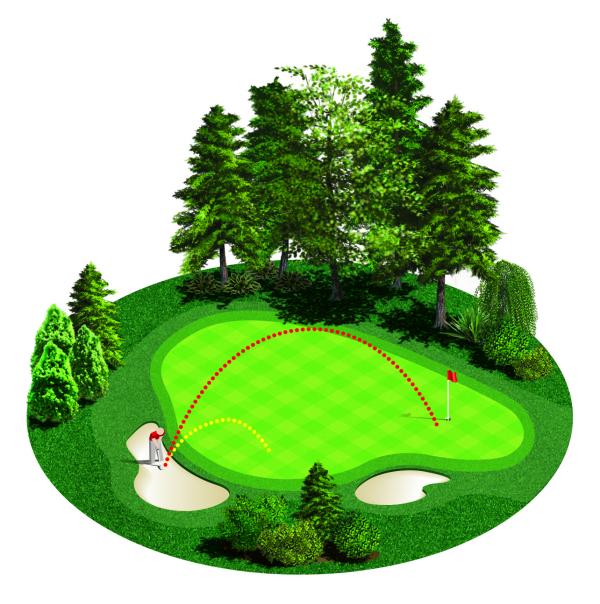Jordan Spieth prevailed in a playoff with Sean O’Hair and Patrick Reed at the Valspar Championship to capture his second PGA TOUR win.
Spieth won on the strength of his short game. He gained 3.2 strokes per round on the field, with more than half, 1.7 strokes, coming from short game shots (shots starting within 100 yards of the hole, excluding putts). Asked about his short game, Spieth said, “That’s something that’s really shined this year.” Here’s a strokes gained breakdown of the top nine finishers at the Valspar Championship:
| Strokes gained per round (ranks in parentheses) | |||||
| Golfer | Total | Drive | Appr | Short | Putt |
| Jordan Spieth | 3.2 (1) | 0.2 (32) | 0.6 (28) | 1.7 (1) | 0.8 (25) |
| Sean O’Hair | 3.2 (T2) | -0.1 (51) | 1.3 (8) | 0.0 (43) | 2.0 (2) |
| Patrick Reed | 3.2 (T2) | 0.1 (35) | 0.0 (46) | 1.3 (3) | 1.8 (3) |
| Henrik Stenson | 3.0 (4) | -0.2 (56) | 1.3 (7) | 0.2 (31) | 1.7 (5) |
| Ryan Moore | 2.7 (5) | 0.4 (12) | 1.6 (1) | 0.3 (21) | 0.5 (33) |
| Troy Merritt | 2.2 (6) | -0.2 (55) | 1.3 (6) | -0.6 (68) | 1.8 (4) |
| Jason Kokrak | 2.0 (T7) | 0.1 (38) | 1.5 (2) | 0.2 (26) | 0.1 (43) |
| Luke Guthrie | 2.0 (T7) | -0.6 (68) | 1.3 (5) | -0.1 (50) | 1.4 (11) |
| Danny Lee | 2.0 (T7) | -0.6 (67) | 1.3 (9) | 0.2 (28) | 1.1 (17) |
| Top 9 average | 2.6 | -0.1 | 1.1 | 0.3 | 1.2 |
| Fraction of total | 100% | -4% | 43% | 13% | 47% |
In the final round, Jordan Spieth’s driving and approach shots were worse than the field. That’s rare for a tournament winner. Spieth said, “Today those were not great swings.” But his short game and putting more than made up for what he lost with his driving and approach shots. Here’s a round-by-round strokes gained breakdown Spieth’s play at the Valspar Championship:
| Strokes gained per round (ranks in parentheses) | Rank | |||||
| Jordan Spieth | Total | Drive | Appr | Short | Putt | out of |
| 2015 Season | 2.3 (2) | 0.4 (30) | 0.5 (34) | 0.8 (4) | 0.6 (16) | 190 |
| Valspar Championship | 3.2 (1) | 0.2 (32) | 0.6 (28) | 1.7 (1) | 0.8 (25) | 71 |
| Round 1 | 1.3 (46) | -1.0 (130) | 2.4 (14) | 0.7 (28) | -0.8 (101) | 144 |
| Round 2 | 5.9 (2) | 1.5 (2) | -0.2 (79) | 3.4 (2) | 1.2 (42) | 144 |
| Round 3 | 4.1 (5) | 1.0 (6) | 0.4 (6) | 1.1 (9) | 1.6 (13) | 71 |
| Round 4 | 1.6 (22) | -0.8 (64) | -0.3 (38) | 1.5 (4) | 1.2 (18) | 71 |
Here’s a strokes gained breakdown of the final round for the top nine finishers at the Valspar Championship:
| Strokes gained in the final round (ranks in parentheses) | |||||
| Player | Total | Drive | Appr | Short | Putt |
| Jordan Spieth | 1.6 (22) | -0.8 (64) | -0.3 (38) | 1.5 (4) | 1.2 (18) |
| Sean O’Hair | 3.6 (7) | -0.3 (56) | 1.9 (7) | -0.1 (39) | 2.1 (10) |
| Patrick Reed | 4.6 (4) | 0.6 (12) | -0.6 (49) | 1.2 (10) | 3.4 (3) |
| Henrik Stenson | 3.6 (5) | 0.0 (43) | 2.7 (4) | -0.3 (44) | 1.3 (17) |
| Ryan Moore | -1.4 (50) | 0.2 (31) | 1.4 (14) | -1.0 (60) | -2.0 (61) |
| Troy Merritt | 4.6 (3) | 0.4 (22) | 1.4 (16) | -0.2 (42) | 3.1 (5) |
| Jason Kokrak | 2.6 (10) | 1.0 (2) | 3.1 (2) | -0.9 (57) | -0.5 (44) |
| Luke Guthrie | 2.6 (17) | -0.4 (59) | 1.8 (9) | 0.2 (29) | 1.0 (21) |
| Danny Lee | 3.6 (9) | -0.3 (54) | -0.5 (48) | 0.9 (16) | 3.6 (2) |
Finally, PGA TOUR veteran Vijay Singh finished in a tie for tenth place at the Valspar Championship. Here’s a strokes gained breakdown of Singh’s four rounds:
| Strokes gained per round (ranks in parentheses) | Rank | |||||
| Vijay Singh | Total | Drive | Appr | Short | Putt | out of |
| 2015 Season | 0.4 (71) | 0.0 (93) | 0.5 (29) | 0.4 (22) | -0.6 (170) | 190 |
| Valspar Championship | 1.7 (T10) | 0.1 (33) | 1.0 (14) | 0.7 (7) | -0.1 (52) | 71 |
| Round 1 | 2.3 (25) | -0.9 (125) | 2.7 (11) | 0.7 (29) | -0.2 (80) | 144 |
| Round 2 | 2.9 (21) | 0.4 (42) | 0.3 (61) | 1.2 (25) | 1.0 (47) | 144 |
| Round 3 | 2.1 (18) | 0.9 (9) | 1.4 (5) | -0.5 (49) | 0.3 (33) | 71 |
| Round 4 | -0.4 (37) | 0.2 (35) | -0.4 (42) | 1.2 (9) | -1.4 (55) | 71 |
This post appeared originally on pgatour.com here
A very brief explanation of strokes gained: Strokes gained is a measure of the quality of a golf shot. A shot with positive strokes gained indicates a better-than-average shot for a PGA TOUR pro. For example, suppose on a difficult par-4 that the PGA TOUR average score is 4.2. An average drive for a PGA TOUR player would reduce the average strokes to hole out by one, from 4.2 to 3.2. If a player hit a long drive into the fairway where the PGA TOUR average strokes to hole out is 2.9, then the shot gained 0.3 strokes compared to the PGA TOUR average. If a player hit a short drive into the rough where the PGA TOUR average strokes to hole out is 3.4, then the shot lost 0.2 strokes compared to the PGA TOUR average. Strokes gained from all shots are accumulated and grouped into convenient categories to measure the performance of players in a round, tournament, or season. For example, the gain from all tee shots on par-4 and par-5 holes is strokes gained driving measure. The gain from all shots starting outside 100 yards from the hole, excluding tee shots on par-4 and par-5 holes, is strokes gained from approach shots.


